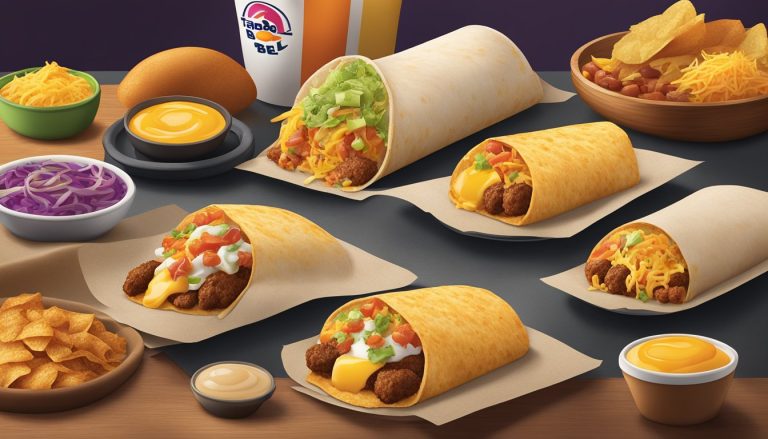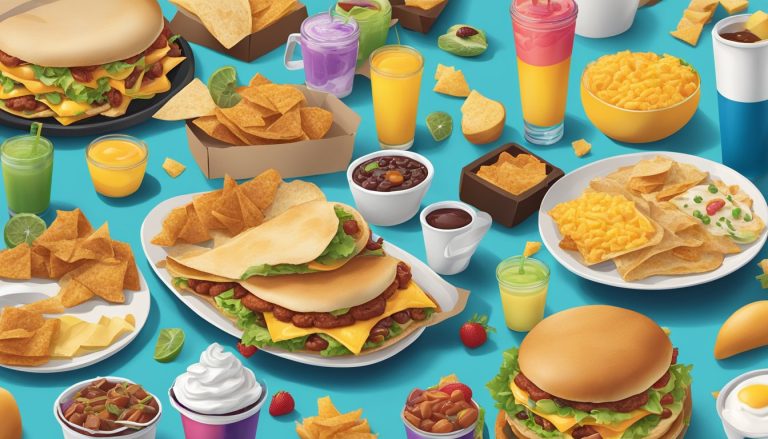Taco Bell’s foray into the breakfast market has sparked considerable interest among fast food enthusiasts. The chain’s unique take on morning meals has garnered attention for its bold flavors and innovative menu items. From the Breakfast Crunchwrap to Cinnabon Delights, Taco Bell offers a distinctive breakfast experience that sets it apart from traditional options.
Customer feedback reveals that many patrons appreciate Taco Bell’s breakfast for its affordability, convenience, and creative flavor combinations. The fusion of Mexican-inspired ingredients with classic breakfast staples has resonated with a diverse range of consumers, particularly young adults seeking quick and satisfying morning meals.
Analyzing customer reviews provides valuable insights into what drives Taco Bell’s breakfast success. Factors such as taste, portion size, and the ability to customize orders frequently appear as positive points in customer feedback. This analysis helps understand why Taco Bell has managed to carve out a niche in the competitive breakfast market.
Taco Bell’s Ascend in the Fast Food Industry

Taco Bell has carved out a unique position in the fast food landscape through strategic growth and innovative offerings. The brand’s success stems from its ability to adapt to changing consumer preferences and leverage creative marketing approaches.
The Evolution of a Breakfast Giant
Taco Bell’s journey to breakfast dominance began with a bold move to challenge established players. The company introduced its breakfast menu nationwide in 2014, featuring Mexican-inspired morning options. This expansion allowed Taco Bell to tap into a new revenue stream and attract a broader customer base.
The brand’s breakfast offerings quickly gained popularity due to their affordability and unique flavors. Items like the Breakfast Crunchwrap and Cinnabon Delights set Taco Bell apart from traditional fast food breakfast menus.
Taco Bell’s marketing efforts played a crucial role in promoting its breakfast menu. The company launched attention-grabbing campaigns that resonated with younger consumers, effectively positioning itself as a fun and unconventional breakfast option.
Integrating Innovation into the Business Model
Innovation has been a cornerstone of Taco Bell’s business model, propelling its growth in the competitive fast food industry. The company consistently introduces new menu items, keeping customers engaged and excited about the brand.
Taco Bell’s partnership with Doritos to create the Doritos Locos Tacos exemplifies its innovative approach. This product became one of the most successful launches in fast food history, driving significant sales growth.
The brand has also embraced technology to enhance customer experience. Taco Bell’s mobile app and website allow for easy ordering and customization, catering to tech-savvy consumers. The company’s drive-thru innovation, including its “Go Mobile” concept, has further streamlined the ordering process.
As part of Yum! Brands, Taco Bell benefits from shared resources and expertise, enabling it to scale innovations across its global network of restaurants. This support has been instrumental in Taco Bell’s continued expansion and success in the fast food industry.
Demystifying the Breakfast Opportunity

Breakfast represents a significant untapped market for fast food chains. Expanding into this meal occasion can drive growth and increase revenue by serving customers during a new daypart.
Identifying the Meal Occasion Niche
Breakfast offers fast food restaurants a chance to capture additional sales by serving customers earlier in the day. Many chains have traditionally focused on lunch and dinner, leaving mornings as an underserved niche.
By offering breakfast items, restaurants can:
- Increase store utilization during previously slow morning hours
- Attract new customers with unique morning menu options
- Boost overall sales without cannibalizing existing lunch/dinner business
However, entering the breakfast market requires careful planning. Chains must develop appealing menu items, adjust operations for earlier hours, and convince customers to change established morning routines.
Case Study: Taco Bell’s Breakfast Revolution
In 2013, Taco Bell explored entering the breakfast market to drive growth. The chain saw breakfast as an opportunity to serve customers during an entirely new meal occasion.
Key aspects of Taco Bell’s breakfast strategy:
- Created unique menu items like the Waffle Taco to differentiate from competitors
- Gradually rolled out breakfast nationally over 6-9 months
- Monitored customer feedback closely to refine offerings
- Adjusted kitchen operations and staffing for earlier hours
While previous breakfast attempts had failed, Taco Bell’s 2014 breakfast launch found success through careful planning and execution. The move allowed Taco Bell to expand its business by tapping into the lucrative morning meal occasion.
Strategic Analyses of Taco Bell’s Expansion

Taco Bell’s expansion strategy relies on comprehensive market analyses and competitive positioning. These assessments guide the company’s growth initiatives and operational decisions.
SWOT Analysis: Strengths, Weaknesses, Opportunities, and Threats
Taco Bell’s strengths include its strong brand recognition and innovative menu offerings. The company’s value-oriented pricing strategy attracts budget-conscious consumers, particularly during economic downturns.
Weaknesses involve perception issues around food quality and nutritional value. Some markets view Taco Bell as unhealthy fast food, potentially limiting expansion in health-conscious regions.
Opportunities exist in international markets, especially in countries with growing middle classes. Taco Bell can leverage its unique Mexican-inspired cuisine to differentiate from competitors.
Threats come from intense competition in the fast-food sector and changing consumer preferences towards healthier options. Rising food costs and supply chain disruptions also pose challenges to Taco Bell’s expansion plans.
PESTEL Analysis: Macro-Environmental Factors
Political factors affecting Taco Bell’s expansion include trade policies and food regulations in target markets. Economic conditions impact consumer spending on quick-service restaurants.
Social trends show increasing demand for convenient, affordable dining options. This aligns with Taco Bell’s value proposition but must be balanced with growing health consciousness.
Technological advancements in food preparation and delivery systems offer opportunities for efficiency and customer experience improvements.
Environmental concerns pressure fast-food chains to adopt sustainable practices. Taco Bell must address packaging waste and sourcing issues.
Legal considerations involve labor laws, franchising regulations, and food safety standards across different jurisdictions.
Porter Five Forces Analysis: Industry Structure and Competitiveness
Threat of new entrants: Moderate. High initial investment and brand loyalty create barriers, but innovative concepts can still disrupt the market.
Bargaining power of suppliers: Low to moderate. Taco Bell’s scale allows for negotiating power, but reliance on specific ingredients can increase supplier influence.
Bargaining power of buyers: High. Customers have many dining options and can easily switch between fast-food chains.
Threat of substitutes: High. Home cooking, meal kits, and other restaurant formats compete for consumer food spending.
Competitive rivalry: Intense. The fast-food industry is saturated, with major players constantly innovating and competing on price and promotions.
Understanding Customer Experience and Feedback
Taco Bell’s breakfast menu has become a significant part of its offerings, with customer feedback playing a crucial role in shaping the experience. The company utilizes various methods to gather and analyze consumer insights.
Analyzing Consumer Behavior Towards Taco Bell’s Breakfast
Taco Bell closely monitors consumer behavior to understand preferences and improve its breakfast menu. The company tracks sales data, social media mentions, and in-store feedback to identify popular items and trends.
Customer surveys reveal that convenience and unique flavor combinations are key drivers for choosing Taco Bell breakfast. Many customers appreciate the ability to customize their orders.
Time-of-day analysis shows peak breakfast hours, allowing Taco Bell to optimize staffing and inventory. This data helps ensure fresh food and quick service during busy periods.
The Role of ‘TellTheBell’ in Gathering Consumer Insights
‘TellTheBell’ is Taco Bell’s primary customer feedback platform. It provides valuable insights into the breakfast experience through targeted surveys and open-ended comments.
The platform allows customers to rate various aspects of their visit, including food quality, service speed, and cleanliness. This data helps identify areas for improvement across locations.
Taco Bell uses sentiment analysis on ‘TellTheBell’ responses to gauge overall satisfaction with breakfast offerings. Positive feedback often highlights innovative menu items, while constructive criticism guides menu updates and staff training.
‘TellTheBell’ also enables Taco Bell to respond directly to customer concerns, demonstrating commitment to service quality and building brand loyalty.
Operational Excellence and Value Proposition

Taco Bell’s breakfast menu success hinges on operational efficiency and a compelling value proposition. These factors drive customer satisfaction and loyalty in the competitive fast-food breakfast market.
Overcoming Operational Issues for Breakfast Success
Taco Bell faced challenges in implementing its breakfast menu. The chain had to train staff on new food preparation techniques and adjust kitchen workflows. They invested in equipment upgrades to handle increased morning traffic.
To streamline operations, Taco Bell simplified its breakfast menu. This reduced complexity and minimized errors during the busy morning rush. The company also optimized its supply chain to ensure fresh ingredients were available early.
Taco Bell implemented a mobile ordering system to speed up service. This allowed customers to place orders in advance, reducing wait times. The chain also focused on drive-thru efficiency, a crucial factor for time-pressed breakfast customers.
Crafting a Unique Value Proposition for Breakfast Foods
Taco Bell differentiated itself from competitors by offering Mexican-inspired breakfast items. This unique approach set them apart in a market dominated by traditional breakfast sandwiches and platters.
The chain emphasized affordability in its breakfast value proposition. They priced items competitively and offered combo meals to appeal to budget-conscious consumers. Taco Bell also highlighted the portability of its breakfast items, catering to on-the-go customers.
Taco Bell’s breakfast menu featured bold flavors and innovative combinations. This appealed to younger consumers seeking exciting breakfast options. The chain regularly introduced limited-time offerings to keep the menu fresh and generate buzz.
Educational Insights for Business Students
Analyzing Taco Bell’s breakfast strategy provides valuable lessons for MBA and EMBA programs. The case study highlights effective market entry, product innovation, and customer feedback utilization.
A Model for MBA and EMBA Curriculums
MBA and EMBA programs can use Taco Bell’s breakfast launch as a model for teaching market expansion strategies. The case demonstrates how to enter a competitive space with innovative products.
Students can learn about consumer research methods and how to apply findings to product development. Taco Bell’s success showcases the importance of understanding target demographics and tailoring offerings accordingly.
The case also illustrates effective branding and marketing techniques. MBA curricula can explore how Taco Bell positioned its breakfast menu to stand out in a crowded market.
Key Takeaways From Taco Bell Case Study Solutions
Taco Bell’s breakfast strategy offers several key lessons for business students:
Product Differentiation: Creating unique items like the Waffle Taco set Taco Bell apart from competitors.
Customer Feedback Integration: Continuously analyzing and acting on customer input led to menu refinements.
Agile Market Response: Taco Bell quickly adjusted its offerings based on sales data and customer preferences.
Cross-Functional Collaboration: The case highlights the importance of teamwork across marketing, product development, and operations.
Data-Driven Decision Making: Taco Bell’s use of analytics to guide menu choices exemplifies modern business practices.
These insights provide practical examples of business theories in action, enriching MBA and EMBA learning experiences.
Taco Bell’s Leadership and Vision

Taco Bell’s leadership guides the company with a clear strategic direction focused on innovation and customer satisfaction. Their vision aligns closely with operational goals to drive growth and maintain a competitive edge in the fast food industry.
Steering the Company with a Clear Vision and Leadership
Taco Bell’s leadership team emphasizes innovation and customer-centric strategies. They prioritize menu creativity, digital transformation, and brand positioning to appeal to younger demographics.
The company’s vision centers on being a category leader in fast food by offering unique, affordable options. This guides decision-making across all levels of the organization.
Leadership encourages a culture of experimentation, allowing for bold marketing campaigns like “Think Outside the Bun” that differentiate Taco Bell from competitors. They also focus on operational efficiency and consistency to maintain quality across thousands of locations.
Aligning the Porter Value Chain Analysis with Strategic Goals
Taco Bell applies Porter’s Value Chain framework to optimize operations and create competitive advantages. In inbound logistics, they work closely with suppliers to ensure fresh ingredients and cost efficiencies.
Their operations emphasize speed and customization, with kitchen layouts designed for quick assembly of menu items. Marketing and sales efforts target tech-savvy consumers through digital channels and loyalty programs.
Service is a key focus, with leadership pushing for improvements in order accuracy and delivery options. Supporting activities like human resource management focus on training staff to deliver consistent customer experiences across locations.
Technology infrastructure investments support mobile ordering and data analytics to inform menu development and targeted promotions. This alignment of value chain activities with strategic goals helps Taco Bell maintain its market position and drive growth.
The Future of Breakfast at Taco Bell

Taco Bell’s breakfast menu continues to evolve, with new innovations and expanded offerings on the horizon. The fast-food chain aims to solidify its position in the competitive morning market.
Prospects and Predictions in the Fast-Food Landscape
Taco Bell is poised to introduce more plant-based breakfast options, catering to the growing demand for vegetarian and vegan choices. The company plans to leverage its signature Tex-Mex flavors in unique breakfast items, setting itself apart from traditional fast-food breakfast menus.
Digital ordering and delivery services will play a crucial role in Taco Bell’s breakfast strategy. The chain is expected to enhance its mobile app capabilities, allowing customers to customize and pre-order their morning meals for quick pickup.
Taco Bell may explore partnerships with popular coffee brands to strengthen its beverage offerings. This move could attract more customers seeking a complete breakfast experience.
To maintain its market share, Taco Bell will likely continue its trend of limited-time breakfast offerings. These promotions generate buzz and encourage repeat visits from curious customers eager to try new flavors.
Marketing Campaigns and Market Penetration

Taco Bell’s breakfast menu has benefited from strategic marketing campaigns aimed at increasing brand awareness and market penetration. These efforts have focused on creative promotions and targeted messaging to attract new customers and drive sales growth in the competitive morning food segment.
Leveraging Marketing Campaigns for Greater Reach
Taco Bell has launched several innovative marketing campaigns to promote its breakfast offerings. The fast-food chain utilized social media platforms to generate buzz around new menu items like the Breakfast Crunchwrap and Cinnabon Delights.
One notable campaign involved partnering with influencers and celebrities to create viral content showcasing Taco Bell’s breakfast options. This strategy helped reach younger demographics and increase engagement on platforms like TikTok and Instagram.
The company also invested in traditional advertising channels, including TV commercials and billboards, to build broader awareness. These ads often featured humorous comparisons to highlight Taco Bell’s unique breakfast menu compared to competitors.
Limited-time promotions, such as free breakfast item giveaways, have been effective in driving trial and repeat visits. Taco Bell has strategically timed these promotions to coincide with key events or seasons to maximize impact and sales.




